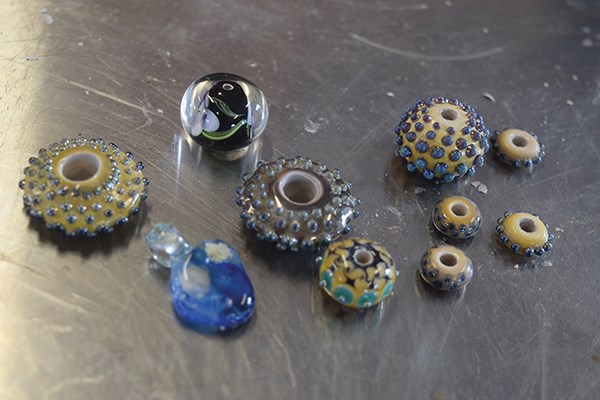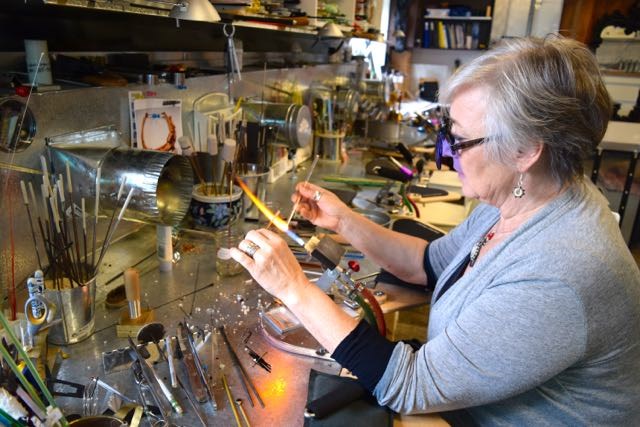On the overcast July afternoon, with its low grey clouds and threat of rain, Andrea Symons’ bright, clean and colourful studio is a refreshing reprieve.
The outbuilding on her Garibaldi Highlands property is the size of a school classroom.
Crisp white cupboards line the walls and a shiny metal-topped table stretches down the middle of the room. Large framed windows let in natural light, which bounces off the beehive-like open faced cupboard full of colourful glass rods that sits above four side-by-side work stations on the right wall.
Each station has a stool, and tools of the trade for creating intricate glass work, including purple-tinted glasses to don before lighting the torch and putting the rods of glass into the dazzling orange flame.
“It is a great way to stay off the streets,” Symons joked, as she dotted white glass onto a blue orb inside the shooting flame. “If you have got an artistic bent it is just a wonderful outlet, because you can play, you can experiment, you can come up with all sorts of different combinations.”
Symons has worked in various mediums over her artistic career, but since another glass artist introduced her to the craft 15 years ago, she’s focused on northwest coast inspired lampwork beads, vessels, and sculptures.
“It just became an addiction, Symons said with a laugh. “It is one of those things you get compulsive about. OK, so that one didn’t work, I can do it better.”
Lampworking can be traced back thousands of years, according to Robert A. Mickelsen, co-author of A Global Overview of Flameworked Glass Art.
“Ancient man is widely presumed to have discovered glass by accident in a campfire, and subsequently learned to make it in small earthen furnaces shaped like beehives,” Mickelsen wrote.
“Using such a ‘small fire,’ ancient artisans could make complex beads and core-formed vessels and could even make hollow tubing centuries before the invention of glassblowing.”
Forming molten glass over an oxygen-propane torch system creates modern lampwork, Symons explained.
Having lived in the corridor most of her life – her parents brought her to Whistler in the early 1960s – Symons’ art reflects local First Nations culture, the Sea to Sky landscape of forests and oceans as well as its wildlife. Symons’ family owned the popular 42-acre Edgewater Lodge property until they sold it last year.
Recently moving to �鶹�����from Pemberton has been inspiring, she said.
“I was in Pemberton for 17 years and love it there… but I didn’t get out and do a lot of my own art stuff,” she said.
“�鶹�����has a real focus on art and I love it for that. There is art everywhere and everyone is very conscious of it and supportive of it.”
Recently, Symons created glass beads destined for the Smithsonian Institution. The museum commissioned an American artist to duplicate an original Pawnee bear claw necklace that had sold at auction, for its collection.
The artist reached out to Symons and asked her to make the pony-trading beads for the piece, which she did.
“It was pretty neat,” she said of making something for the world’s largest museum.
Symons acknowledges she could likely get much more exposure for her work – she sells it on her website, at local craft shows and on the craft-selling website Etsy – but she is not great at promoting herself.
“I am a little more modest about it,” she said, visibly wincing at the thought of “bragging” to others about her art. “It is hard to, sort of, pound your own drum.”
What she is more comfortable with is sharing her craft. She is willing to teach anyone who wants to learn how to work with glass, she said.
“If somebody is interested in it, I will happily share this knowledge,” she said.
To see Symons’ work or request a class with her, go to .




